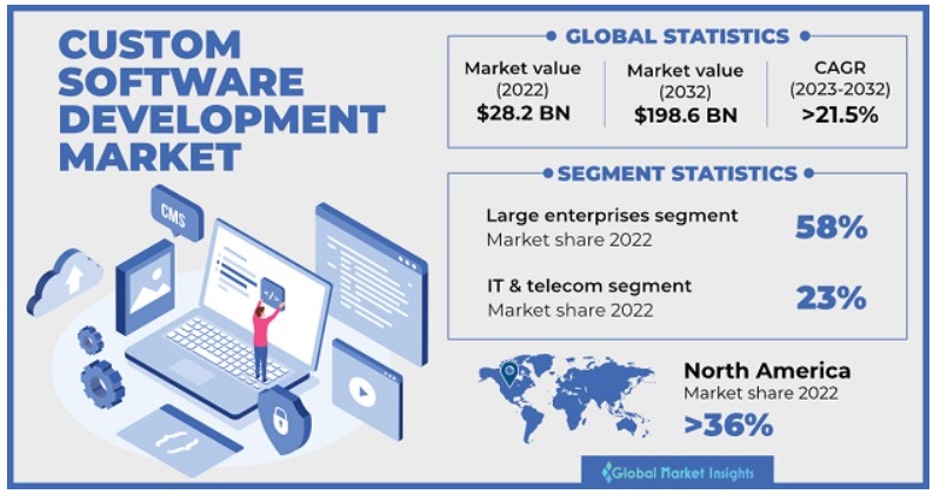The healthcare industry has seen rapid technological advancements in recent years, especially when developing innovative custom medical software solutions. Custom healthcare software caters to the unique needs and workflows of a medical practice, hospital, laboratory, or other healthcare organization. Investing in tailored clinical, administrative, and analytics solutions can drive efficiency, productivity, and patient care to new levels.
As value-based care and preventative health continue gaining momentum, healthcare providers need agile tools to manage population health, enable precision medicine, and meet stringent regulatory compliance requirements. Artificial intelligence, mHealth apps, wearables, blockchain, remote patient monitoring, and advanced data analytics are just some of the latest technologies making their mark by Empeek’s team opinion.

What key innovations and benefits drive the demand for custom health services software development today? Let’s explore it.
Optimizing Clinical Workflows
Every healthcare organization has unique systems, processes, protocols, and objectives. Generic off-the-shelf software often falls short of meeting specialized workflow needs. Custom solutions can integrate tightly with existing EHR infrastructure and capture process nuances to help clinicians work smarter – not harder. Intuitive clinical software with built-in best practice alerts and templates enhances patient encounters, diagnosis, treatment planning, referrals, and care transitions across the continuum. Patient portals, remote monitoring apps, and wearables also engage patients in shared decision-making.
Improving Operational Efficiency
Administrative and operational inefficiency continues plaguing healthcare. Recent survey findings revealed clinicians spend nearly twice as much time on EHR data entry than direct patient care. Custom software connects previously disconnected systems to eliminate duplicative data entry and paperwork. This allows staff more face time with patients versus screens. Automating mundane tasks also reduces errors that undermine productivity and revenue. Built-in analytics measure KPIs to identify performance gaps and opportunities in real-time. Accurate operational benchmarking ensures practices remain profitable on the journey to value-based reimbursement models.
Advancing Personalized Medicine
The age of mass patient management has given way to highly customized, analytics-based medicine. Researchers now understand how genetics, environment, lifestyle factors, and social determinants impact diseases differently across patient subpopulations. This requires smarter software to capture multidimensional data for tailored treatments, precision diagnostics, and risk stratification applications. Custom offshore healthcare software development allows folding evidence-based clinical decision support and the latest medical research into EHR workflows at the point of care. Prescriptive analytics and AI-based tools can match therapies to patients for optimal therapy selections and outcomes.
Improving Patient Safety & Care Quality
Medical errors contribute to hundreds of thousands of patient deaths per year. Healthcare lags behind other industries that are notorious for risky work conditions. Custom apps build checks and balances into workflows to enhance patient safety. They embed clinical guidelines in everyday processes, so clinicians can easily make sound decisions. Apps that reduce misdiagnoses, adverse drug events, hospital readmissions, and healthcare-acquired infections have saved many lives. Real-time warnings for critical, abnormal lab values or changes in clinical status also prompt timely interventions before conditions spiral out of control. Preventative care and proactive population health management help minimize errors and life-threatening events.
Driving Public Health & Research Goals
Custom software also advances public health objectives. Analytics identify community disease hot spots for targeted intervention campaigns. They fuel clinical trials by matching patients to experimental therapies faster. Public health apps track epidemics, model disease spread, predict outbreaks, and manage disaster or bioterrorism response. Healthcare and government agencies tap custom development for specialized population data analysis needs across programs. This leads to policies addressing broader socioeconomic barriers to community well-being over the long term.
Meeting Compliance Mandates
Regular compliance updates remain unavoidable and challenging workflow disruptors. Failure to meet quality reporting and meaningful use timelines results in stiff penalties. Custom software helps healthcare organizations comply with perpetual mandates and minimize revenue losses. Solutions come preloaded with the latest code sets, templates, and measure calculation logic. Automatic data validation checks reduce errors that lead to inaccurate quality measure submissions or claims denials. Real-time analytics also identify problem areas early. Ongoing compliance is sustainable without the high software upgrade costs and implementation headaches.
The advantages driving demand for custom medical software are clear. The next challenge lies in approaching development for optimal clinical and financial ROI.
Strategic Approach to Custom Medical Software Projects
Healthcare organizations have unique priorities and constraints. Most seek a healthcare software development company that can make a solution aligned with long-term strategic goals. However, many still struggle to bridge the gap between IT and clinical end users resistant to disruptive change. Close cross-functional collaboration and Interoperability testing early on helps achieve stakeholder buy-in.
Organizations also desire future-proof architecture that can easily incorporate innovations. It should maximize existing IT and infrastructural investments, rather than necessitating expensive overhauls. Cloud-based solutions ensure easy scaling, upgrades, and accessibility without exorbitant maintenance costs. React Native, MongoDB, and microservices foster flexibility to refresh apps via over-the-air updates.
Finding specialized healthcare technology consultants facilitates success from the planning phase onwards. Ideally, medical domain expertise should fuse with niche IT competencies for ideal functional specifications. Understanding clinician perspectives and patient priorities will lead to impactful human-centered design. An iterative agile approach further allows refinement based on real-world testing feedback.
Robust cybersecurity protections also rank among the top criteria given prolific data breaches. HIPAA technical safeguards and compliance should be integral to architecture from day one. Otherwise, audits may detect vulnerabilities, resulting in hefty penalties later.
Lastly, healthcare enterprises desire custom applications to interface with third-party population health and patient engagement tools. Scale and stability must support large data loads, analytics complexity, and reliable uptime. Perfecting integration, testing, training, and maintenance ensures a smooth launch and sustains lasting ROI.
The Next Wave of Innovation
While technological progress in healthcare may seem frenetic already, it continues accelerating. Advanced custom solutions will likely support even more expansive goals sooner than imagined. They include curing diseases, reversing climate change ramifications, enhancing accessibility and affordability, and protecting global public health. The COVID-19 pandemic underscored the need for resilient systems to withstand and contain outbreaks. Future innovations must bolster data sharing and actionable insights at lightning speed.
Ultimately, the most promising technology trends empower patients and providers with knowledge. They reduce discrimination, build healthier societies, sustain planet resources, and save more lives. Custom clinical software development makes personalized, predictive, and preventative precision healthcare possible. The only limitations are what we envision possible.
Author Bio:
Roman is the co-founder of Empeek who brings a breadth of knowledge to build, scale, and transform healthcare organizations. He specializes in revitalizing struggling businesses and turning them into profitable enterprises. By emphasizing automation and effectively navigating the transition from startup to a sustainable and scalable model, Roman drives remarkable transformations to ensure long-term success.
LinkedIn: https://www.linkedin.com/in/roman-konstantinov-empeek/

The post Impact of Custom Medical Software on Healthcare appeared first on The Crazy Programmer.
from The Crazy Programmer https://ift.tt/sx9KWyX
Comments
Post a Comment